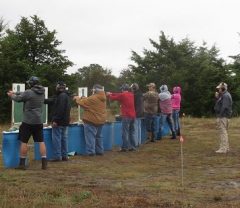by Sandy Keathley
I had a pistol class the other day. We spent time learning about handguns, how they work, safety rules, ammo, loading, cleaning, stance, grip, etc. After some dry-firing, we went to the range. There was a young woman in the class, who had never even held a gun, much less fired one, but she was given a semi-auto for her birthday, and wanted to learn about it the right way. I give her credit for that, as many people just go to a range, point, pull the trigger, and hope for the best.
Her gun was a polymer 9mm, so muzzle-flip was expected, especially for a new shooter. She was nervous, and intimidated by the range noise (indoor range). I was right at her elbow the whole time, and that helped. The first time she fired, she almost jumped out of her skin. The next few shots were trepidatious, and she was ready to go home. I let her sit out while someone else shot, then made her shoot again. The third time she came up, I gave her a choice of shoot one more time, or go home. She said “let’s shoot!“.
By the third time, she could shoot a 6-inch group at 3 yards, which, in my view, is pretty good for a brand new shooter.
She left feeling pretty good about herself, excited by the experience, and wanting more. Her comment, though, common for new shooters, was, “it wasn’t what I expected.” I told her, it’s not like it looks on TV.
Thinking back on it, I can see how intimidating the first range experience can be. It was busy that day, crowds of people, some of whom knew where they were going. You have to go through several doors to get into the shooting bays. It was dark in there, and hot, and very loud. People were hammering away with all kinds of guns, brass was flying, the floor was littered, there were no RSOs evident. I’m surprised anyone would go to a range the first time without a guide to show them the ropes.
If you are a shooter, you know that shooting a gun is very empowering. It requires responsibility, and accurate shooting requires controlling all those factors that would distract from the goal: stance, grip, control, breathing, visual focus, mental focus. When you get all those ducks in a row, you feel that you have succeeded in controlling a device of unimaginable power, like defeating the dragon. With a high like that, who needs drugs?



